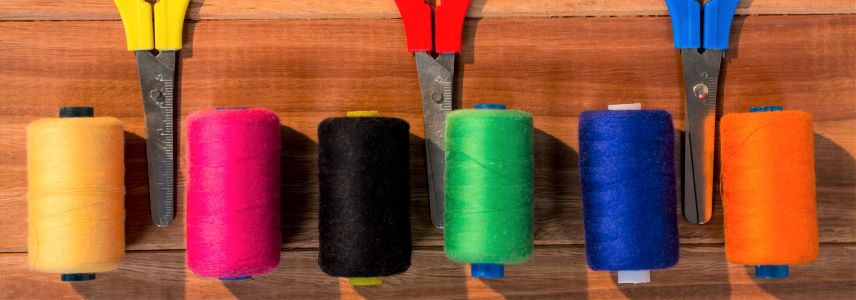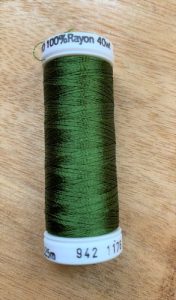

A Yarn About Threads
June 28, 2023

Hi!
This week we’re sharing a great article from Australian Quilter Bev McClune, that was in our magazine several years ago. It’s about the threads we use for our sewing and quilting, and is a really handy refresher on all things thread – ranging from weight and size (and that those numbers really mean), how to pair it with the correct needle size and a quick look at a bunch of different thread types.
Have a quick read through again – you might just pick up a tip!

A Yarn About Threads
Depending on the project, you want to quilt, the thread types available each have something special to offer. The best way to learn about threads is to play with different ones and discover the effects each will have in various situations.
One important tip to keep in mind is you should always be able to break the thread by pulling on it between your two hands. If you cannot break it, do not use it for quilting! It is actually too strong and in time will wear and perhaps cut through your quilt. Put it to use in the garden to support your plants instead.
Threads come in different weights. Unlike when you step on a scale, a smaller number actually signifies that the thread is thicker. Remember, the smaller the number, the thicker the thread and the higher the number, the finer the thread. A spool of thread that has 30 wt on it is going to be thicker than a spool of thread that has 40 wt written on it.

Keep in mind that needle sizes work like dress sizes which is the opposite of how thread works. The lower the size on the needle the smaller or thinner it is, and the lower the weight of thread the thicker it is.
Ply is another word used to describe thread. A ply is one strand of thread and one-ply thread will naturally be a very weak thread. Three-ply thread is three strands of thread twisted together and will be a stronger thread.
It is important to consider the characteristics of thread types when choosing which to use in your quilting project.
Cotton thread is a natural fibre and has been around forever. Commonly used in many piecing and quilting projects it is available in various weights.
Polyester thread is a man-made fibre. It is quite a strong thread.
Rayon thread is generally considered a natural fibre. It is also a strong thread. When used in quilting it has a beautiful shine that looks a little like silk.

Metallic thread is a man-made fibre. Historically this thread was actually fine wires of gold, silver and copper. Nowadays the fibre content of metallic thread is not usually so exotic but rather polyester or a polyester and nylon blend.
Silk thread is a natural fibre (and probably one of the most expensive threads). It looks exquisite when used for quilting designs on quilts – especially in traditional quilting.
Monofilament is a man-made fibre. Many people despise this thread but it can be absolutely “tops” in many circumstances. It comes as 100% nylon or 100% polyester. The nylon is preferable to the polyester as the nylon is very fine, soft and flexible – almost like hair. It is not like fishing line!

If the monofilament thread you have tried before is thick and hard like fishing line throw the stuff away and make sure you buy a quality monofilament thread from your quilt store. The polyester seems not as fine as the nylon and perhaps has a little less “stretch” to it. A good quality monofilament will be easy, flexible and soft to use.
If you tried monofilament thread in the past and given up on it – do give it another try! With a quality monofilament thread, you will find that the benefits outweigh the drawbacks.
- It comes in clear and smoke colour. The clear is good on light fabrics (e.g. pastels and medium colours) while the smoke works well on darker colours.
- It is great to use “in the ditch”, around appliqués and embroidery, etc. Wherever this thread is used, it is almost invisible and is very comforting when you are learning to quilt a quilt, especially when stitching “in the ditch”. If you happen to oops out of the ditch on any colour of fabric, it is not noticeable. This makes it an ideal thread for beginner machine quilters. Straying from the ditch will leave an obvious sign if using any other type of thread.
- It is smart choice of thread when you want to quilt designs on many different coloured fabrics. It blends beautifully with the fabric, which is better than trying to choose the correct tone on tone colour of thread for every different coloured fabric you wish to quilt.
- Do be aware that you need to be careful when using the iron near these monofilament threads, as they are a little heat sensitive (the nylon is more sensitive than the polyester). Generally, it is not necessary to put an iron anywhere near a quilted quilt so this should not present a major problem.
Now that you have decided on what thread you will use here’s a final tip.
There are mainly two different methods of winding thread on to the spool – parallel and cross-wound. Cross-wound threads behave better when placed on a horizontal spool pin. Parallel wound threads behave best when placed on a vertical spool pin. To prevent the thread from twisting and knotting, you may need to place parallel wound threads on a thread stand, placed a small distance to the back of the machine.
Acknowledgements:
About the Author: Since discovering quilting ten years ago Bev McClune has become an award winning domestic machine quilter, a professional machine quilter and a popular tutor.
Article Source: http://EzineArticles.com/?expert=Bev_McClune
Hope there was a handy tip in there for you!
I discovered that I actually have more thread than I thought I had, tucked away in various little hidey holes, so I’m off to pull it all out and have a proper look at what’s there, so can I actually use it!
I tend to use white, grey, beige, black or navy for piecing, and often I just use that for my quilting too, because it’s there and I like how it quilts up. I did find some pretty colours though, that really should be put to use…
Enjoy your week!



Thankyou, good to know about current monofilament thread, I gave up on it years ago, especially with the difficulty tying it off securely. How do you tie off the modern version, do you still need to melt the ends
Hi Lyn! No – the new monofilament thread is easy – I usually just do a couple of backstitches like normal, and it holds fine. It is quite thin and really soft now. I don’t love it in the bobbin (my machine is a bit temperamental), so I often just use a thin regular cotton thread in the bobbin and the monofilament on top.
What about thread weights? They can be confusing. For example: My local quilt shop uses 60 wt in all their classes (piecing, quilting) except the applique classes. However, if I shop online, it’s hard to find 60 wt. 50 wt is everywhere. So, what is the best piecing, bobbin , and quilting weights?
I use 50wt thread for my piecing and most of my quilting. I just like that it’s thin and still strong. I know many prefer a heavier weight thread for quilting – this is better if you want your quilting stitches to stand out more on top of the fabric. I know it’s not much help, but there’s no definite ‘right’ or ‘wrong’ here – it comes down to personal choice. Have a play around and see what you’re most comfortable with.
I don’t adjust the tension on my machine much, and I find it works best on my machine to use the same thread in the bobbin as what’s on the top. Again, it’s something to play around with – if you want a heavier thread on top to show up and a finer bobbin thread to disappear more on the back of the quilt, you will just need to stitch some samples and play with the tension to get it right.
Thankyou for this comprehensive study. Even at my age it’s always good to find something new to learn. I haven’t sewn for quite a while but I thoroughly enjoy catching up on up-to-date information. I also liked the photos very much.
Sincere thanks indeed for sending your interesting news and information quite frequently. I am not doing much adventurous quilting these days, but your patterns and hints really appreciated and inspiring.
Thanks Elizabeth! I’m so glad you’re enjoying them.
You made my day! 🙂